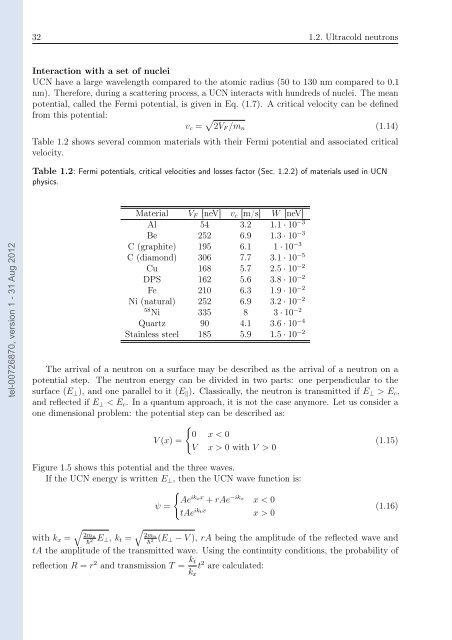Développement et optimisation d'un système de polarisation de ...
Développement et optimisation d'un système de polarisation de ...
Développement et optimisation d'un système de polarisation de ...
Create successful ePaper yourself
Turn your PDF publications into a flip-book with our unique Google optimized e-Paper software.
tel-00726870, version 1 - 31 Aug 2012<br />
32 1.2. Ultracold neutrons<br />
Interaction with a s<strong>et</strong> of nuclei<br />
UCN have a large wavelength compared to the atomic radius (50 to 130 nm compared to 0.1<br />
nm). Therefore, during a scattering process, a UCN interacts with hundreds of nuclei. The mean<br />
potential, called the Fermi potential, is given in Eq. (1.7). A critical velocity can be <strong>de</strong>fined<br />
from this potential:<br />
vc = 2VF /mn<br />
(1.14)<br />
Table 1.2 shows several common materials with their Fermi potential and associated critical<br />
velocity.<br />
Table 1.2: Fermi potentials, critical velocities and losses factor (Sec. 1.2.2) of materials used in UCN<br />
physics.<br />
Material VF [neV] vc [m/s] W [neV]<br />
Al 54 3.2 1.1 · 10 −3<br />
Be 252 6.9 1.3 · 10 −3<br />
C (graphite) 195 6.1 1 · 10 −3<br />
C (diamond) 306 7.7 3.1 · 10 −5<br />
Cu 168 5.7 2.5 · 10 −2<br />
DPS 162 5.6 3.8 · 10 −2<br />
Fe 210 6.3 1.9 · 10 −2<br />
Ni (natural) 252 6.9 3.2 · 10 −2<br />
58 Ni 335 8 3 · 10 −2<br />
Quartz 90 4.1 3.6 · 10 −4<br />
Stainless steel 185 5.9 1.5 · 10 −2<br />
The arrival of a neutron on a surface may be <strong>de</strong>scribed as the arrival of a neutron on a<br />
potential step. The neutron energy can be divi<strong>de</strong>d in two parts: one perpendicular to the<br />
surface (E⊥), and one parallel to it (E). Classically, the neutron is transmitted if E⊥ > Ec,<br />
and reflected if E⊥ < Ec. In a quantum approach, it is not the case anymore. L<strong>et</strong> us consi<strong>de</strong>r a<br />
one dimensional problem: the potential step can be <strong>de</strong>scribed as:<br />
<br />
0 x < 0<br />
V (x) =<br />
(1.15)<br />
V x > 0 with V > 0<br />
Figure 1.5 shows this potential and the three waves.<br />
If the UCN energy is written E⊥, then the UCN wave function is:<br />
ψ =<br />
<br />
Ae ikxx + rAe −ikx x < 0<br />
tAe iktx x > 0<br />
(1.16)<br />
<br />
2mn<br />
¯h 2 <br />
2mn<br />
E⊥, kt = ¯h 2 (E⊥ − V ), rA being the amplitu<strong>de</strong> of the reflected wave and<br />
with kx =<br />
tA the amplitu<strong>de</strong> of the transmitted wave. Using the continuity conditions, the probability of<br />
reflection R = r2 and transmission T = kt<br />
t2 are calculated:<br />
kx

















